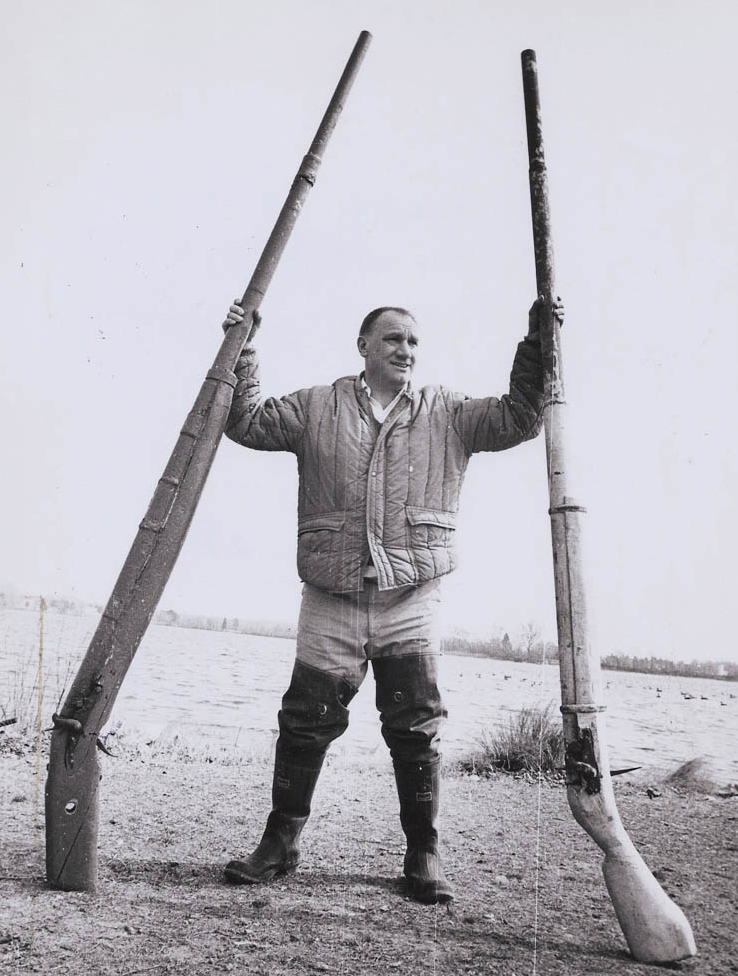Chronicling a vanished era of waterfowl hunting as “The Outlaw gunner” returns to rightful prominence
Written by Joe Willey
The flat horizon of the Eastern Shore spreads in all directions. Slow-moving tidal rivers wind through marshes prickling with reeds, and slick with rich black mud. As the seasons change from summer to fall, migratory birds soar across the high clouds. They used to come in waves of thousands, coloring the sky and the surface of rivers. Hunters waited for them. These men were canny, brave and deadly—and may have been forgotten without Dr. Harry Walsh and his book The Outlaw Gunner.
Harry Walsh was the oldest of six children and grew up poor. He supported his mother and siblings by hunting and trapping. Around him, hunters did what they could to survive, and illegal hunting flourished. He understood hardship. During World War II, he served in the Pacific theater as a frogman in the Scouts and Raiders—the precursor of the Navy SEALs.
Later, Walsh received an athletic scholarship to Washington College in Chestertown, MD, and then worked to put himself through medical school. But he is most remembered for being a beloved, local doctor and the author of The Outlaw Gunner—a classic book about the lives and tools of men who hunted professionally to provide food for regional restaurants and their kitchen tables.
The Outlaw Gunner is not a dry history of a lost way of life but a colorful story of punt guns and people, sneak skiffs and survival. His son, Joe Walsh, who was always a student of his father, knows what drove him to write the classic book.
The book tells stories of hunters and the danger they faced that was as constant as the tide. The punt gun, or long gun, is a large shotgun secured to an easily maneuvered, flat, small boat. It was a deadly weapon that could kill dozens of waterfowl with one blast.
But the weapon could be lethal for the hunters, too. The temperamental guns often kicked with such ferocity that men would be knocked overboard and drown in the icy water. Some guns, their barrels unknowingly cracked, would explode and maim or kill a hunter. With the advent of the Migratory Bird Treaty Act of 1918, the era of commercial hunting whispered out of existence.
Most of the guns are gone, and the boats rotted, but with a foreknowledge many wish they had, Dr. Harry Walsh preserved historically important pieces. His knowledge was deep, and his collection was impressive. He was also generous, donating most of his collection to the Chesapeake Maritime Museum in St. Michaels and the U.S. Fish and Wildlife Service in Chincoteague.
The book tells stories of hunters and the danger they faced that was as constant as the tide. The punt gun is a large shotgun secured to an easily maneuvered, flat, small boat. It was a deadly weapon that could kill dozens of waterfowl with one blast. But the weapon could be lethal for the hunters, too.

Through the end of this year, his son, Joe Walsh, and the Talbot Historical Society have partnered to present “Outlaw Gunner,” an exhibit based on the book. This exhibition is an informative and thoughtful tribute to the history of hunters, their legacy, and the hope expressed in the final chapters—for conservation.
Harry Walsh did not stop there. In 1971, the same year The Outlaw Gunner was published, he and a few others founded the Waterfowl Festival—which will celebrate its 53rd edition this November. Committed to the Eastern Shore’s rich hunting and conservation history, the chronicler of the infamous punt gun served as the event’s first chairman.

AT THE READY
Dr. Harry Walsh holds two punt guns, embodying the perilous legacy of Eastern Shore waterfowl hunting.


The Outlaw Gunner is a story of unique people. Walsh’s original book and the updated 2020 hardback edition tell of the devastating and dangerous life of commercial bird hunters on the Eastern Shore. At the same time, it places the reader on the frigid surface of those bitterly cold and perilous waters. Commercial hunters lying flat in a small boat on a glassy surface with a finger on the trigger may be gone. But because of Dr. Harry Walsh, their way of life will not be forgotten.
Visit the Talbot Historical Society to view its newest exhibit, “Outlaw Gunner,” chronicling the history of waterfowl and the Chesapeake Bay through the eyes of Dr. Harry Walsh. Museum hours: Wednesdays through Saturdays from 10 a.m.-3 p.m.
